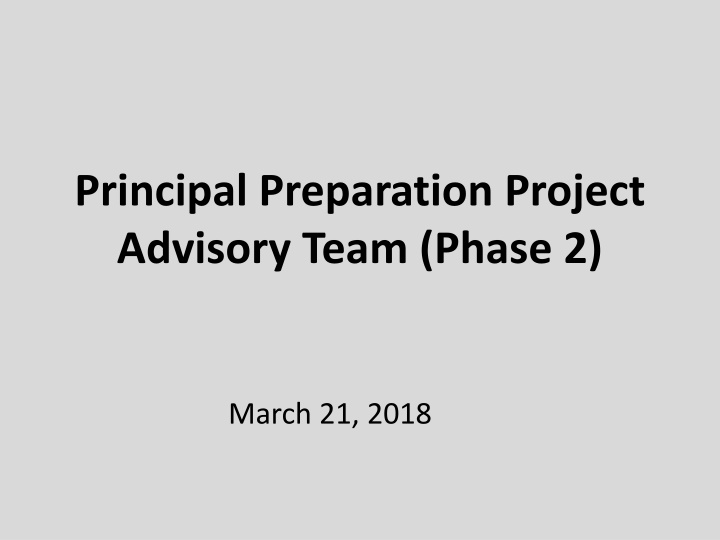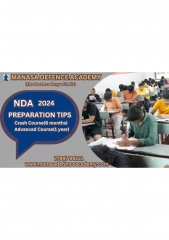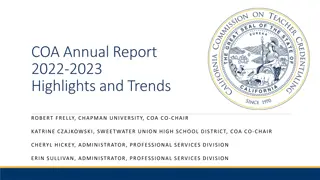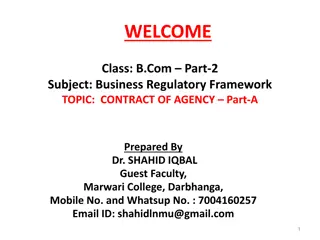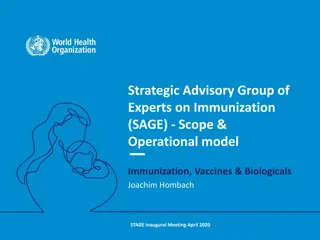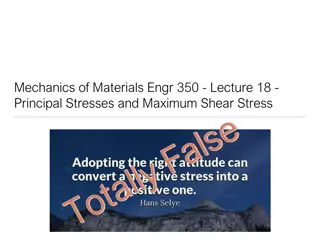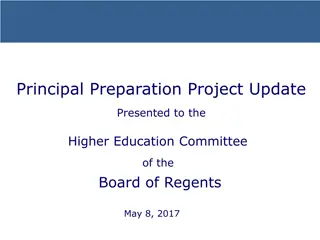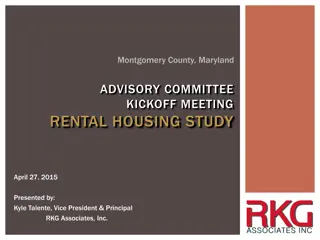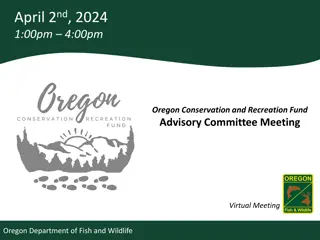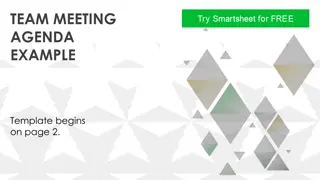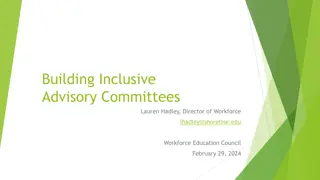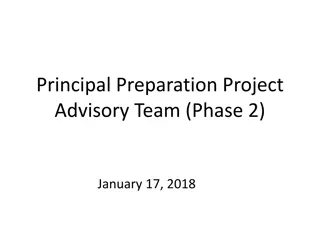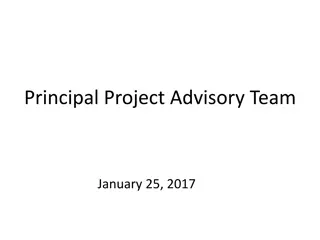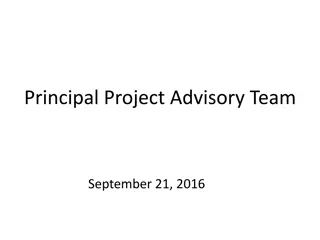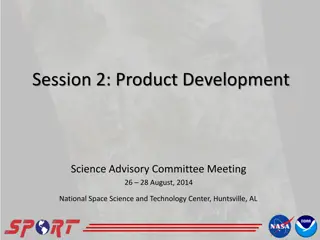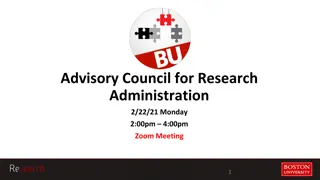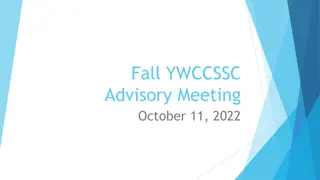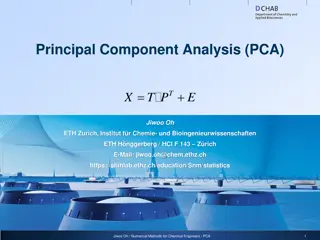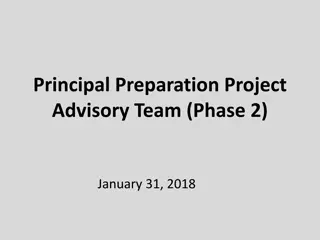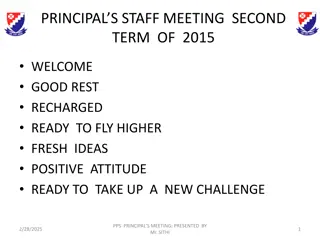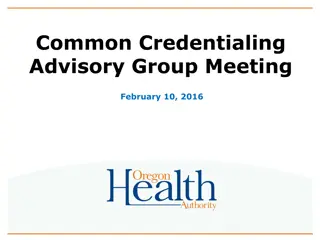Principal Preparation Project Advisory Team Meeting Highlights
This document showcases the agenda and discussions from a Principal Preparation Project Advisory Team meeting. Topics include consensus-building techniques, project updates, logic models, and guidance for school turnaround leaders.
Download Presentation

Please find below an Image/Link to download the presentation.
The content on the website is provided AS IS for your information and personal use only. It may not be sold, licensed, or shared on other websites without obtaining consent from the author.If you encounter any issues during the download, it is possible that the publisher has removed the file from their server.
You are allowed to download the files provided on this website for personal or commercial use, subject to the condition that they are used lawfully. All files are the property of their respective owners.
The content on the website is provided AS IS for your information and personal use only. It may not be sold, licensed, or shared on other websites without obtaining consent from the author.
E N D
Presentation Transcript
Principal Preparation Project Advisory Team (Phase 2) March 21, 2018
Agenda Item #1 Welcome by the Chairs (10:30 am) - Gladys Cruz - Suzanne Rosenblith - Reggie Landeau Introductions 2
Agenda Item #2 (see pg 1 in folder) Goal Identify recommendations we support by consensus 3
Friendly Reminder: Reaching consensus Fist to Five The goal is to something that every member can live with and support. When co-chairs call a question, members show hands to show support. Those who hold up 3, 4, or 5 fingers support the option 2 fingers means I cannot live with it as is 1 finger means A larger reservation prevents me from supporting it Showing a fist means I cannot support it, as a matter of conscience. Note: Options that are forwarded enjoy consensus support. For these, every Team member shows 3, 4, or 5 fingers. Those who show a fist, 1, or 2 fingers will be asked, What would it take to make this something you can live with and support?
Whats happened since last meeting Project management is passing to SED staff 5
Agenda Item #3 Minutes (see pages 2-16 in folder) - Accept as is or agree on needed change. 6
Agenda Item #4 Logic Models (10:35 am 10:40 am) Context ESSA requires this if using Title IIA for principal prep Objective Decide whether to support a revised logic model Note Changes suggested in our Feb. 28, 2018 meeting: - Unpack outputs (short-, medium-, long-term) - Provide rationale for the problem statement - Investigate to see whether activities and outputs that appear should be hypothesized or actual 7
Where do we look for guidance? See pg 17 in your folder (competencies for school turnaround leaders) 8
Logic Model Guidance (RAND, 2017, pg 4) A logic model presents a framework that identifies the components of proposed strategy (i.e., the includes active ingredients that are hypothesized to be critical to achieving the relevant outcomes) and also shows and describes how key components and outcomes are related, theoretically and operationally (U.S. Department of Education, 2016) Source: Logic Models for Selecting, Designing, and Implementing Evidence-Based School Leadership Interventions (L. Daugherty, R. Herman, F. Unlu, RAND, 2017) 11
The Problem (RAND, 2017, pg. 9) Many states and districts struggle with a shortage of new principals who possess competencies needed for effective leadership. Attending training programs, principal candidates often do not receive coursework and clinical experiences that prepare them for leadership positions in real life. After graduation, new principals often do not receive sufficient support and mentoring. 12
Intervention Types (RAND, 2017, pg. 9) RAND identifies 6 intervention types (policy levers): - Principal preparation programs - Recruitment, selection, and placement - Supervision and evaluation - Professional learning - Working conditions - School improvement 13
Prep Program Interventions (RAND, 2017, pg. 9) Leadership interventions broadly include any effort to improve leadership capacity in schools by altering programs, practices, or policies. Interventions can include specialized programs that target certain groups of principals or districtwide/statewide practices that affect all principals. Interventions can be developed in-house by states and districts,purchasedfrom external organizations, or developed collaboratively 14
Prep Program Interventions(RAND, 2017, pg. 9) A principal preparation program aims to prepare current and aspiring educators to become principals through training that combines high-quality classroom instruction and some type of school-based internship. These programs can lead to an advanced degree or certification. They may be provided by universities, districts, or independent organizations or some combination 15
SBL exam competencies (See pg 55-61 in folder) Examples of NYS competencies (SBL exam, Pearson) - Instructional leadership - School culture and learning - Developing human capital - Family and community engagement - Operations, data, and legal 23
Agenda Item #5 First Principles (10:40 am 11:00 am) Objective Decide how many and which to adopt. Activity Use SurveyMonkey results (from February). Be ready to use Fist-to-Five. Consensus recommendations go forward. 27
First Principles (supported by all respondents to February survey) The Foundation Realizing educational excellence and equity throughout NYS requires well-trained leaders who have a convincing command of competencies associated with the Professional Standards for Educational Leaders (PSELs). 28
First Principles (supported by all respondents to February survey) Purpose and Effect We agree with Linda Darling Hammond. The intent is to create a P20 educational system that learns to get better at getting better. Improving principal preparation contributes to school and student success. 29
First Principles (supported by all respondents to February survey) Feedback and Data Feedback is at the heart of learning to get better; thus data collection, analysis, and reporting are vital because they make it possible to gauge whether activity translates into improvement. 30
First Principles (supported by all respondents to February survey) P20 Partnership Districts are clients of (and partners with) preparation programs; so close and ongoing feedback between field- based practitioners and university-based programs are essential elements of principal preparation 31
First Principles (supported by all respondents to February survey) Mentoring and Coaching Because continuous learning is a necessity, principals need ongoing support in the form of high-quality mentoring and coaching up to and beyond the full first year on the job 32
First Principles (not yet supported by all survey respondents) Quality is the Driver, not Dollars (survey included one 1 and one 2 ) The ability of program graduates to assume a leadership role and lead schools to higher ground is not just the aim and purpose of preparation programs but the driver of program success (not revenue generation). 33
First Principles (not yet supported by all survey respondents) Aim of Prep Program (survey included one 2 ) Sound programs equip candidates to lead schools in continuous school improvement and to lead turnaround in schools that struggle most. 34
First Principles (not yet supported by all survey respondents) Competency Matters Most (survey included one 1 and one 2 ) Candidates enrolled in preparation programs demonstrate certification readiness by leading efforts at a district school that lift staff, student, or school performance. 35
First Principles (not yet supported by all survey respondents) Defensible Judgments (survey included two 2s ) We work toward ensuring that judgments about the adequacy of preparation programs and/or candidate readiness for certification are reliable, valid for their purpose, and comparable across individual, program, and year. 36
First Principles (not yet supported by all survey respondents) Residency (survey included four 2s ) During a full-time, year-long, (ideally paid), school-based internship, candidates identify problems of practice and design and lead interventions that help improve opportunities and outcomes for staff and students. 37
Agenda Item #6 (see pg 1, pg 18-21, and pg 22-28 in folder) Straw Poll (11:00 am 11:05 am) Objective If we called the question now, determine how much support exists for recommendations from each group. 38
Agenda Item #7 (see pg. 1, pg 18-21, and pg 22-28 in folder) Food for Thought (11:05 am 11:30 am) Objective One by one, each small group provides flyover on its recommendations and invites input from colleagues. 39
Agenda Item #8 Small Team Breakout Sessions (11:30 am 12:45 pm) Objective Finalize recommendation concepts and phrasing. Activity Over working lunch, use colleague input to finalize recommendations (note changes on chart paper). Re-convene (ready to report out) when video ends. https://duckduckgo.com/?q=paul+sings+nessum+dorma+idol&t=hg&atb=v103-5_f&ia=videos&iai=2I3Ha8PABzc 40
Agenda Item #9 (see pg. 1, pg 18-21, and pg 22-28 in folder) Report out (12:45 pm 1:15 pm) Objective Understand proposed final phrasing Activity Small group leaders summarize, field questions 41
Agenda Item #10 Calling the Question (1:15 pm 1:45 pm) Objective Identify recommendations having consensus support Activity Use Fist-to-Five 42
Agenda Item #11 Overview of Final Report (1:45 pm 2:00 pm) Objective Identify elements of the final report Activity Acknowledgments; members, chairs, group leaders How Phase 2 builds on work of our predecessors Evidence base Process for assembling consensus First principles, logic model (if approved) Recommendations 43
Agenda Item #12 Possible next steps (2:00 pm 2:15 pm) Objective Decide our response if asked about next steps. 44
Agenda Item #13 Evaluating this effort (2:15 pm 2:30 pm) Objective Identify strengths and areas of possible improvement in process and product 45
- ADJOURN 46
